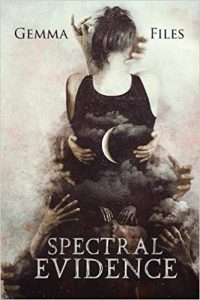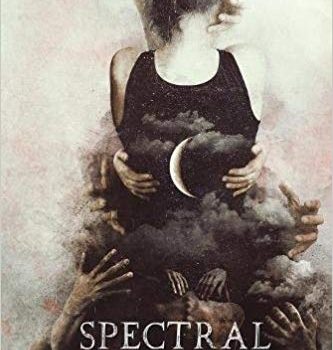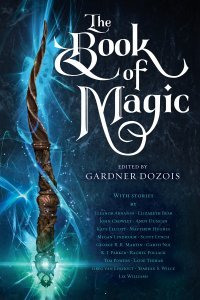John Langan Reviews Spectral Evidence by Gemma Files
 Spectral Evidence, Gemma Files (Trepidatio 9781947654181 $15.95, 212pp, tp) February 2018.
Spectral Evidence, Gemma Files (Trepidatio 9781947654181 $15.95, 212pp, tp) February 2018.
Spectral Evidence, Gemma Files’s excellent new collection, is her first such book since 2004’s The Worm in Every Heart (2014 did bring We Will All Go Down Together, which assembled a number of shorter works, but it did so in the interest of fashioning them into a larger whole, a kind of hyper-novel, which is a different, though clearly related, form). If it seems remarkable that so much time has elapsed since her last collection, that is because her short fiction has been appearing in a multitude of venues for some years now. It’s marked by a style that is simultaneously muscular and elastic, densely textured and fluid, able to shoulder a wide range of allusions to culture high and low while propelling the narrative forward. In his retrospective review of the reissue of Files’s first two collections in the pages of this magazine, Laird Barron described Files’s aesthetic as a punk one, and there’s something to the description. As in punk music, there’s a deep awareness of the sources of the genre combined with a desire to renovate them by using them to address fresh concerns. Thus, Files’s fiction makes references to a wide range of forebearers, from Clive Barker to the Supernatural TV series, and it uses them to explore questions of power and desire, of the liminal and the lost. Fascinated by the outsider, Files tends toward characters who exist on the margins of society, of this world and others. Perhaps most of all, what Files’s fiction shares with punk is its tremendous energy, its verve, its sheer fun.
The opening story, “A Wish from a Bone”, displays many of Files’s strengths. Originally published in Ellen Datlow’s Fearful Symmetries, it employs just such an arrangement, specifically, among a type of angel called the Maskim. These are seven angels who originally formed a single unit (what one of the story’s characters calls “the Voltron angel”). Together, these beings brought creation into existence and then separated. Were they to reassemble, they would rend the universe asunder. One of the characters relates this story in a temple on the border between Eritrea and Sudan, to which a film crew has come to shoot the kind of quasi-sensationalized fare that increasingly appears in the programming schedules of even the more sober networks. Ancient, the structure is a study in several types of impossibility, its walls full of the fossils of sea creatures from an ocean that never existed in this location, preserved in perfect rows that intersect those above and below to form hybrids, weird chimera. Of course, the temple is dedicated to the Maskim, and of course they are going to appear, heralding the imminent destruction of everything. It’s as if the mere existence of such a place dictates that its discovery will summon its subjects. Soon, the Maskim possess several of the film crew, and the world is on the verge of coming to an end. But there’s a wrinkle in the plan: at least some of the angels have lost interest in fulfilling their purpose. They like – or at least, prefer – creation to its lack. These angels thus become involved in the effort to thwart their own purpose. In its description of geological mystery and strange fossils, the story nods in the direction of Lovecraftian concerns with deep time and weird biology, yet it takes a sharp right turn from there towards a Christian or even gnostic inspired vision of angelic creation. Nor is Files afraid to allow her non-human and human characters to communicate with one another, and to discover that their interests might coincide.
This concern with incorporating the perspective of the non- or only partially human extends to the other stories in the collection. In “When I’m Armoring my Belly”, for example, the protagonist has willingly offered to himself to a group of vampires as their Renfield, in no small part because he is the child of a freshly turned vampire and a human. A misfit among humans, Benjamin hopes for acceptance among the vampires, but they are uninterested in what they consider a hybrid. Lacking a place among both the living and the undead, he finally engineers his transformation into something beyond the two of them, a new kind of monster which preys on vampires, yet still retains a human familiar. Allfair Chatwin, the protagonist of “Crossing the River”, is a similar blend of human and monster, in her case, a demon. While her paternity facilitates her career as a witch, it does nothing to curb the bad habits that land her in prison. There, she encounters a pair of women known to her as hunters and slayers of supernatural creatures, including witches. One of them, she recognizes as a child of the same infernal father, a half-sister, with whom she agrees to cooperate in order to escape their imprisonment. In the figures of Samaire and Dionne Cornish, it’s possible to recognize gender-swapped versions of the protagonists of the long-running Supernatural TV show; however, what might have veered into simple fan-fiction becomes something more rich and interesting. (Something similar happened in Files’s Hexslinger trilogy of weird western novels, which drew inspiration from the 2007 remake of 3:10 to Yuma and went in stunningly bizarre directions.) In “Guising”, the first-person narrator recounts a childhood visit to the land of the Fae on Halloween night, a reverie which ends with her realization that an ancestor had a child with one of the fairy court, and so the blood of the Fae runs in her veins.
Files’s fascination with characters caught between the two registers of existence is accompanied by a corresponding concern with family, literal and figurative. This is the case in the two stories in which Allfair Chatwin recurs, “Black Bush” and “His Face, All Red”. In the first, she returns to the place of her birth and upbringing in search of her dead mother’s bones. On her way, she meets a young woman on a quest to locate her missing and possibly dead brother. The two agree to join forces, with the result that Allfair is able to meet her true father. In “His Face, All Red”, Allfair comes once more into contact with the sisters, Samaire and Dionne, this time when all three of them are on the trail of the same vampire. This vampire, it turns out, is the scion of a family famous for fighting vampires and has been made one of the undead by his lifelong adversary. His children and grandchildren wish him captured so they can perform a spell on him that will restore his humanity. Even monsters have families; even monsters need families.
With the award-winning Experimental Film, Gemma Files wrote one of the signature novels of the early 21st century. Spectral Evidence is a reminder of her mastery of the shorter form. The author biography at the book’s end announces another two collections of her stories forthcoming.
John Langan is the author of two novels, The Fisherman (2016) and House of Windows (Night Shade 2009), and two collections of stories, The Wide Carnivorous Sky and Other Monstrous Geographies (2013) and Mr. Gaunt and Other Uneasy Encounters (2008). With Paul Tremblay, he co-edited Creatures: Thirty Years of Monsters (2011). One of the founders of the Shirley Jackson Awards, he served as a juror for its first three years. He lives in New York’s Mid-Hudson Valley with his wife and younger son.
This review and more like it in the August 2018 issue of Locus.
 While you are here, please take a moment to support Locus with a one-time or recurring donation. We rely on reader donations to keep the magazine and site going, and would like to keep the site paywall free, but WE NEED YOUR FINANCIAL SUPPORT to continue quality coverage of the science fiction and fantasy field.
While you are here, please take a moment to support Locus with a one-time or recurring donation. We rely on reader donations to keep the magazine and site going, and would like to keep the site paywall free, but WE NEED YOUR FINANCIAL SUPPORT to continue quality coverage of the science fiction and fantasy field.






